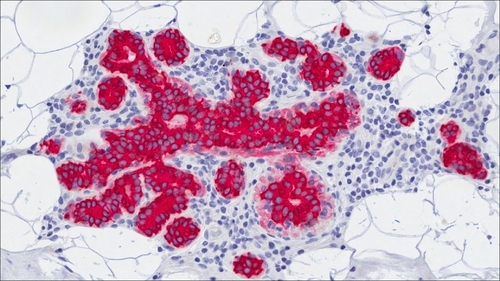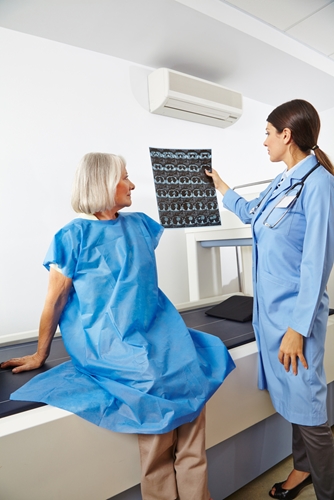Over the past two years, key cancer-prevention groups like the American Cancer Society and the U.S. Preventive Services Task Force have amended their breast cancer screening guidelines to address rising false-positive rates among women below the age of 50. Last year, the USPSTF analyzed data from three separate mammography trials and found that the cumulative false-positive rate for all participants was 42 percent, annually. The biennial rate was 61 percent. And, these test results contributed to an overdiagnosis rate as high as 22 percent. The panel took this data into account when it reaffirmed its controversial guidelines earlier this month, reported The New York Times.
Medical professionals offered predictable criticism.
"The harm of a missed curable cancer is something profound," Dr. Clifford Hudis, director of breast cancer medicine at Memorial Sloan Kettering Cancer Center, said in an interview with the paper. "The harm of an unnecessary biopsy seems somewhat less to me."
This episode perfectly encapsulates the ongoing debate surrounding breast cancer screening recommendations. Preventive organizations attempt to protect both the minds and bodies of women while members of the medical community err on the side of caution and focus solely on anatomy.
Challenging Conventions
For over three decades, preventive groups uniformly championed early-detection regimens, reported Mother Jones. Radiologists and oncologists thought breast cancer was a single disease that, like many illnesses, developed in logical and observable stages. If breast cancer was a process, then physicians could use medical imaging tools to detect it in infancy and destroy it before metastasis.
Medical researchers now know that breast cancer is actually a body of disparate conditions that unfold in different ways. According to Breastcancer.org, there are 14 different types. Some of these develop in deliberate phases and are rarely lethal. Others grow rapidly, transforming from cell surplus into malignant mass without regard for established stages. With most life-threatening cancers, early detection isn't an option. And, according to some, regular screening doesn't do much for slow-moving cases either, as many of these cancers simply don't pose a mortal threat. Some even fizzle out on their own, reported an international cancer research team.
In a 2014 study published in The Journal of the American Medical Association, the USPSTF estimated that out of 10,000 50-year-old women who underwent regular screening for 10 years, only 302 would receive a positive breast cancer diagnosis. Of those 302 women, only 10 would survive as a result of early detection, while 62 would succumb to cancer despite the screening. Conversely, researchers estimated that approximately 6,130 women would experience at least one false-positive over the same span. Additionally, 940 women were projected to undergo an unnecessary biopsy.
False-positives can be particularly traumatic for some women, reported The New York Times. The psychological effects can last for years.
"False-positive findings on screening mammography causes long-term psychosocial harm: three years after a false-positive finding, women experience psycho-social consequences that range between those experienced by women with a normal mammogram and those with a diagnosis of breast cancer," wrote Dr. John Brodersen and Volkert Dirk Siersma, Ph.D., in a report on the psychology of false-positives.
Studies like these – along with the patient-centered care revolution – have convinced some preventive organizations to issue more relaxed screening guidelines.
"They are saying that they realize we now need to think about the balance of benefits and harms for each individual when we're making decisions about who to test," Dr. Nancy Keating, a physician at Brigham and Women's Hospital, said in an interview with The Washington Post. "It's no longer as simple as saying everybody needs a mammogram."
Physicians Fight Back
Most oncologists favor early detection regimens and argue against these newer guidelines for a variety of reasons.
Some take issue with research upon which preventive groups base their lax guidelines. These breast cancer experts say some false-positive studies fail to take into account recent advances in screening technology, reported CNN. In these cases, researchers cite data points collected during an era dominated by film mammography machines. Digital mammography machines, which produce high-quality, editable images, were only recently adopted by clinics. The difference in image quality between the two methods is noticeable.
"It's like standard versus HD TV," Dr. Therese Bevers, the medical director of the Cancer Prevention Center at the University of Texas MD Anderson Cancer Center, told CNN.
According to a study published in Radiology, these newer machines do, in fact, lower false-positive rates. In 2008, only 32 percent of clinics had at least one digital mammography machine, reported The New York Times.
In the coming years, advanced screening technology like the 3-D mammography machine will enter the market and push false-positive rates even lower.
"It is very much taking hold in the breast-imaging world," Dr. Sarah Friedewald, a radiologist at Advocate Lutheran General Hospital, said in an interview with The Times. "We found an increase in invasive cancers, the ones we worry about, that could be lethal. Overall, it's very encouraging. We're also reducing the number of people who have to come back."
Others in the field are bothered by how preventive organizations are interpreting data on mammogram effectiveness. While crafting their guidelines, groups like the USPSTF looked at how mammography affected the breast cancer mortality rate. Despite what slogans may say, screening does not actually save many lives, reported Time magazine. And preventive experts will readily admit that. However, they do believe screening catches many cancers early, which helps women avoid costly and physically taxing treatments like chemotherapy.
"The American Cancer Society made the value judgment that screening is only worth it if it improves survival," Breastcancer.org President Dr. Marisa Weiss said in an interview with CNN. "There's an arrogance to that. Let women decide what's meaningful to them."
The data supports this view. In 2013, physicians from Harvard Medical School studied the medical records of women who died from breast cancer in Harvard's teaching hospitals, reported The Washington Post. According to their research, published in the journal Cancer, 70 percent of the patients didn't undergo regular screening prior to receiving a positive diagnosis. Additionally, half were in their 40s when they were diagnosed.
"Screening is not responsible for 'overdiagnosis' – pathologists make the diagnosis. Screening is not responsible for 'overtreatment' – oncologists decide on treatment," Dr. Daniel Kopans, a radiology professor at Harvard Medical School, told the paper. "Women should not be deprived of life-saving screening because medical care is not perfect."
Despite these dissenting opinions, opponents of the established early-detection doctrine say they will continue to caution women about the dangers of overtreatment until more sophisticated screening tools are developed.
"Radiologists are working hard to find new and better screening tests, which we desperately need, but I think it will take time," Keating said.
Contact Viztek for more information.
Ronny Bachrach
Latest posts by Ronny Bachrach (see all)
- Konica Minolta Debuts First-of-Its-Kind Digital U-Arm System at AHRA - July 27, 2016
- Researchers Detect Signs Of Stroke Risk Using MRI - June 27, 2016
- Imaging Biz: Q&A with David S. Channin MD: How to Make PACS Patient Centered - June 22, 2016










